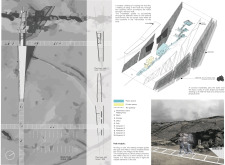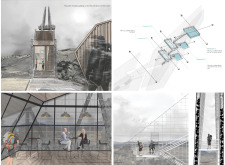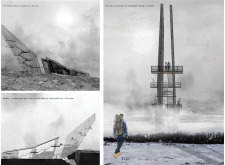5 key facts about this project
Structural Innovation and Material Use
The architectural form of the project is defined by its towering presence, which resembles an elongated gateway. This shape not only serves as a visual marker of the fault line but also facilitates the flow of visitors through various levels. The design incorporates steel as the primary structural material, ensuring stability while allowing for expansive spaces. Large glass panels are utilized in the observation platforms, providing unobstructed views of Iceland’s dramatic landscapes. The choice of volcanic rock as a material reinforces the connection to the site, creating both aesthetic and contextual relevance. Wood is employed in certain internal areas, including rest spots and cafés, to foster warmth and comfort in contrast to the steel and glass components.
Pathways and User Experience
A significant aspect of the design is the pathway system that connects different elements of the project. These pathways lead visitors through the varying spatial dimensions, encouraging exploration and interaction with the architecture as well as the landscape. The tiered observation areas allow for panoramic views, aligning with the concept of traversing the fault line. This experience is further enriched by dynamic viewpoints, which change with the visitor's movement within the space. The integration of public spaces is another focal point, as communal areas for information and relaxation are woven into the fabric of the design, enhancing social interaction.
Engagement with Geography
The architectural design meticulously responds to the geographical context of its location in the Icelandic landscape. By articulating the concept of the fault through structural elements, the project embodies the natural processes that shape the land. The careful consideration of material choices, including locally-sourced volcanic rock, further solidifies the building’s relationship with its environment. The result is a structure that stands not only as an observation point but as a platform for education and understanding of geological features.
For a comprehensive exploration of the "In Between" project, including detailed architectural plans, sections, and design ideas, readers are encouraged to delve deeper into the presentation of the project. This examination will provide valuable insights into the unique architectural approach and the elements that make this project distinct within the broader context of contemporary architecture.


























